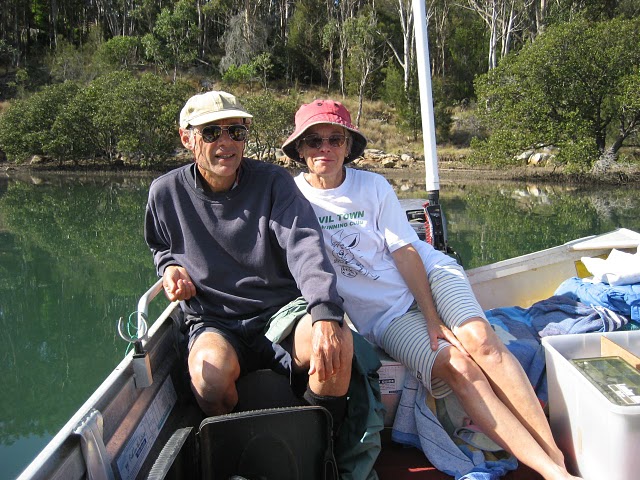| BACK |

BSc (Hons) Zoology. Australian National University, 1973.
PhD Zoology, University of British Columbia, Canada, 1978.
Lecturer, Biochemistry, University of Nairobi, 1979-82, plus married Sarah.
Lecturer/Associate Professor, Biochemistry, University of Western Australia, 1984-2004.
Retired on 20 hectares in the bush near Moruya, NSW, doing a long-term study on the breeding of woodland birds.
Below are the papers I published in the last 5 years of my career as a biochemist, to give you an idea of my interests. These are followed by a couple of scientific books and some popular articles and books.
Right at the end is a brief summary of what Sarah and I are now doing on our property.
61. Guppy M, Reeves, D C, Bishop T, Withers P, Buckingham, J A, Brand MD (2000) Intrinsic metabolic depression in cells isolated from the hepatopancreas of estivating snails. FASEB 14: 999-1004
62 Abas L, Bogoyevitch MA, Guppy M (2000) Mitochondrial ATP production is necessary for activation of the extracellular-signal-regulated kinases during ischaemia/reperfusion in rat myocyte-derived H9c2 cells. Biochem. J. 349: 119-126.
63 Pakay JL, Withers PC, Hobbs AA, Guppy M (2002) The in vivo down-regulation of protein synthesis in the snail Helix apersa during estivation. Am. J. Physiol. 283: R 197-R204
64. Guppy M, Leedman P, Zu XinLin, Russel V (2002). Contribution by Different Fuels and Metabolic Pathways to the Total ATP Turnover of Proliferating MCF-7 Breast Cancer Cells. Biochem. J. 364: 309-315.
65. Casey, T M, Pakay J L, Guppy M, Arthur P G (2002) Hypoxia causes down-regulation of protein and rnRNA synthesis in non-contracting mammalian cardiomyocytes. Circ. Res. 90: 777-783.
66. Guppy, M (2002) The Hypoxic Core: A possible answer to the cancer paradox. Biochem. Biophys. Res. Commun. 299: 676-680.
67. Pakay, JL, Hobbs, AH, Guppy, M (2003). Pre-absoprtion of a polyclonal antibody raised against a peptide – keyhole limpet haemocyanin conjugate to allow analysis of molluscan protein. Journal of Molluscan Studies 69: 157-159.
68. Pakay JL, Hobbs AH, Kimball SR, Guppy M (2003). The role of eukaryotic initiation factor 2a during the metabolic depression associated with aestivation. J. Exp. Biol. 206: 2363-2371.
69. Zu X, Guppy M (2004). Cancer metabolism: Facts, fantasy and fiction. Biochem. Biophys. Res. Commun. 313: 459-465.
70. Guppy M (2004). The biochemistry of metabolic depression: a history of perceptions. Comp. Biochem. Physiol. 139B: 435-442.
71. Guppy M, Brunner S, Buchanan M (2005) Metabolic depression: a responses of cancer cells to hypoxia? Comp. Biochem. Physiol. 140B: 233-239.
Scientific Books
Hochachka, PW and Guppy M (1987). Metabolic Arrest and the Control of Biological Time. Harvard University Press, Cambridge, Massachusetts.
Guppy M (2008) Energy Processing in Cells. Recurring Concepts and Themes. Athena Press, London.
Popular Articles.
Guppy M and Guppy S (1983) On Sarari with Tiger Beetles. Swara, 6: 30-32.
Guppy M (1984) A Conversation in the Bush. Geo 6: 58-67.
Guppy M and Guppy S (2009) Watching Nests. Wingspan 19 (4) 44-46.
Popular Books.
Guppy M (2000) The Rats of Ravenna. Seaview Press, Adelaide.
A Long-Term Study of the Breeding of Woodland Birds.
We are doing a long-term study of the breeding biology of woodland birds. Our study site is 10 ha of woodland, five km NE of Moruya, NSW. The property was bought in 1973 by Stephen Marchant. He surveyed and cleared the tracks for a 50 m grid, and did a meticulous and comprehensive study on the breeding biology of the birds covering the years 1975-1984. The data were subsequently published as Occasional Publication No.1 (1992) under the auspices of the Eurobodalla Natural History Society, a society that Stephen founded in 1986.
In 2006, we (Sarah is Stephen’s daughter) began the mammoth task of attempting to repeat Stephen’s study, in the same area, using the same grid (rediscovered and re-cleared), 20 years later. The aim is to continue the repeat study for at least five breeding seasons.
We are now in the middle of our fourth season (2009/2010). We spend about 450 hours on the site between August and January (inclusive), and most of our time is spent finding nests. We find about 130 nests a year representing 29 species.
A lot of the birds are now colour banded, and the data we get each year is distilled into the following categories:
Nests/year (total and for each species), nesting period for each species, minimum number of breeding pairs for each species, percent of nests judged successful for each species, and maximum nesting attempts per pair for each species.